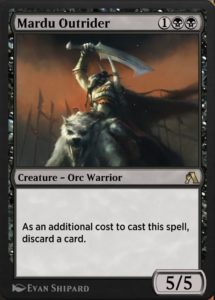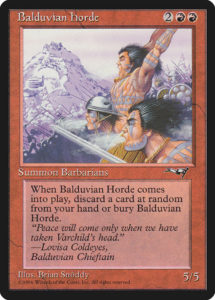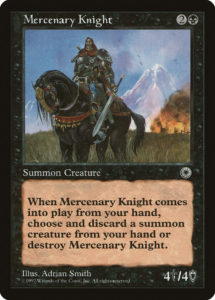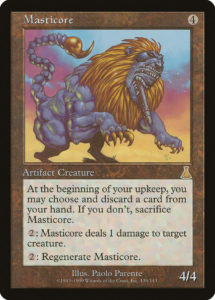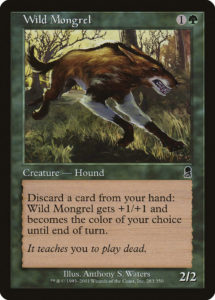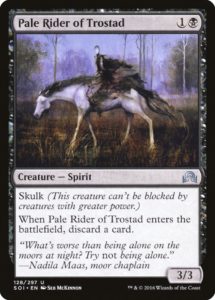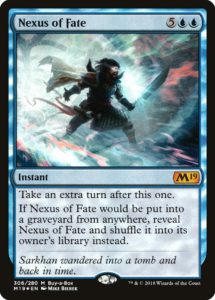Ever seen this card?
Until last week, I didn’t know Mardu Outrider existed. I knew that Arena had introduced new cards—Inspiring Commander being the most notable creation, since depending on who and when you ask, it’s a color pie break, a bend, or acceptable new space for white. But Arena has been quietly adding new cards that are legal in BO1 Standard, and Mardu Outrider is perhaps the most powerful of the lot. It also draws from a deep design well going back to Magic’s first few years.
Back in ’96, people thought that Balduvian Horde was the second coming of Juzám Djinn, one of Magic’s most powerful creatures ever at that point. It was not. Turns out, discarding a card at random is an incredibly hefty cost, especially when Terror and Swords to Plowshares are available.
1997 introduced two new takes on the Horde with Hidden Horror and Mercenary Knight. They color-shifted the ability to black, removed, the random discard, and lopped off a mana, a power, and a toughness for the trouble. Interestingly, Mercenary Knight has both a superior mana cost and creature types (though at the time knight and human tribal didn’t exist).
This concept of a creature requiring the hefty cost of card disadvantage has slowly been used over the years. 1999’s Masticore took this concept to the extreme, forcing regularly discards in exchange for a creature that could kill enough things to arguably recoup the loss. Razormane Masticore, Molten-Tail Masticore, and Rotting Regisaur would later on play in this same space.
In 2001, Odyssey turned many Magic heuristics on their head, particularly card advantage. While in ’96, discarding a single card to Balduvian Horde could be devastating, Wild Mongrel and Psychatog converted cards into raw stats while enabling Madness and Threshold. For the first time in Magic’s history, it was easy to turn discard into value—unless you were playing red, the only color still forced to discard at random.
The Cult of Rakdos burst onto the scene in 2006’s Dissension. Drekavac introduced a card type restriction to the formula of stats-for-card-disadvantage, but Avatar of Discord went the Masticore route and offered unheard-of stats for the enormous investment of three cards up front. They synergized with the Rakdos mechanic Hellbent, but without Madness to recoup the lost value this innovation didn’t prove powerful. Psychatog and Wild Mongrel were so good because the threat of activation made life difficult for your opponent and you had total control of when to discard cards—making that investment immediately is just asking for trouble.
Contemporary Magic has made some tweaks to the Hidden Horror formula. Creatures no longer sacrifice themselves if you cannot discard a card. If Pale Rider is the last card in your hand, then congratulations—you circumvented its disadvantage (though by waiting until it’s your last card, you lose out on primary advantage of being undercosted). While the rider and Bazaar Trademage retained the familiar enters-the-battlefield text,Lesser Masticore and Sparkhunter Masticore opt for the cleaner but generally weaker templating of requiring the discard as a cost.
And that brings us to our newest addition, Mardu Outrider. It’s got Hidden Horror mana cost, Juzám Djinn‘s stats, and Lesser Masticore‘s templating. It doesn’t exist alongside Madness, Threshold, or Delirium to turn its downside into a benefit, but it does follow in the footsteps of Standard powerhouse, Rotting Regisaur.
What I love about Mardu Outrider, and frankly, most Magic design in general, is just how much precedent, design intent, and iteration are evident in every card, from Virtual Vanilla to Questing Beast. Mardu Outrider gets to lean on Arena’s interface to ensure new players are ready to pay the mandatory cost, rather than have them be surprised when it enters the battlefield and demands a card as payment. Sure, you lose the moment of “black cards involve dangerous deals that you can avoid paying,” but it enforces the earlier lesson of “black cards involve dangerous deals.”
There’s the outstanding question of whether the Arena cards will come to paper Magic. There’s likely little demand for Zephyr Gull; and while Goblin Gang Leader is a strong card, I don’t think many decks need a fifth copy of Beetleback Chief. But Soulhunter Rakshasa, Inspiring Commander, and Mardu Outrider are strong cards.
What happens if Mardu Outrider becomes a player at a BO1 Standard tournament, but isn’t available in BO3? We’ve had a taste of this when Nexus of Fate was banned in BO1 but legal in BO3. That wasn’t a big problem. Frankly, paper card legality likely won’t be a concern for for some time, and if this problem does arise, Magic has time to respond. Moreover, these aren’t the first digital Magic cards unavailable in paper—there seem to be scant demand for Aswan Jaguar or Faerie Dragon.
An advantage of these cards is that by being purely digital, they can be patched. In fact, it seems Soulhunter Rakshasa has already changed. Given the many Standard bannings, one could imagine a future where Arena exclusives are pushed hard to make it easier to step off the gas when the format breaks. This seems farfetched at present, given that Magic remains a heavily paper and creating two separate Standard formats presents major business and balances challenges. But if competitive play remains on Arena past the pandemic and paper play shies away from Standard, patchable digital exclusives could become a more attractive solution. Time will tell, and we’ve got some time before we get there.
Until then, and as always, thanks for reading.
—Zachary Barash is a New York City-based game designer and the commissioner of Team Draft League. He designs for Kingdom Death: Monster, has a Game Design MFA from the NYU Game Center, and does freelance game design. When the stars align, he streams Magic (but the stars align way less often than he’d like).

